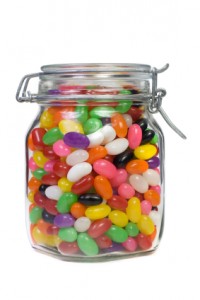In my last article, we explored how our fear of regret could inhibit us from taking action. Let’s stay on the same psychological path but change things up a bit. Instead of focusing on our tendency to do nothing, let’s look at something that influences our minds when take action. Go ahead and grab your Erlenmeyer flask, it’s time for an experiment.
Open your mind up for a second. It’s time for two tasks
1. Think about how much you weigh. Don’t be embarrassed, you don’t have to say it out loud. Got it?
Perfect. Now that one was easy. It gets harder.
2. How many jelly beans do you think it takes to equal one pound? Think about how many jelly beans collectively add up to one pound. This shouldn’t be as easy as part 1.
Results
These were actual questions I have been asking friends, family members, and co-workers for the past few weeks. Each time I got the same “what the hell are you talking about?” kind of reaction. Once the stoning stopped, I received exactly what I wanted.
The guesses I received ranged from 100-200 jelly beans. In other words, it would take 100-200 jelly beans to equal one pound. Some guesses were closer to 100 while others stretched closer to 200, but each response I received was within the range.
The correct answer is 400. How is that for some common knowledge? 400 jelly beans equals one pound.
Sneaky, sneaky
What kind of psychological experiment would it be if there was no twist? You realize whatever psychologists tell you they’re testing is a complete lie. They’re always studying something deeper.
After I got the answers I wanted, I sought out to ask more questions (you know – to find something deeper).
- How old are you?
- How many jelly beans do you think it takes to equal one pound?
In each set of questions, the first question is completely unrelated to the second question. Your weight and your age have nothing to do with how many jelly beans equal one pound; however, leading with two different questions yielded completely different results.
The ranger of answers I received this second time around was 10-80.
Anchors Away
There is a term in psychology and behavioral economics known as anchoring. According to Wiki, anchoring is a “cognitive bias that describes the common human tendency to rely too heavily on one trait or piece of information when making decisions.”
In the above experiment, my guinea pigs had either their weight or their age fresh in their minds which affected their guess of jelly beans. It doesn’t matter that there is zero correlation between the two, the bias is still present.
How Does This Affect Me and My Money?
How many times have you gone shopping at a department store and the item in question has a number of different prices on it?
Recommended Retail Price: $80
Today’s Sales Price: $60
Take Another 10% Off!: $54
Looky there! What a deal you’re getting. You’re getting an item that was initially selling for $80 for $54. Why wouldn’t you buy this? Worst case scenario, you buy it so that you can sell it later for $80 right?
Wrong.
Companies know how your mind works better than you know how your mind works. They are fully aware of your tendency to get weighed down by anchors. That’s why they throw out some arbitrary number. Because when your mind sees that you’re “getting a deal,” you get all excited.
Conclusion
If you want to be a smart consumer, go out and buy the things that you want and need. But whatever you do, don’t let coupons influence your buying decisions. Don’t let discounts influence whether or not you buy something. Don’t let the value that someone else places on an item affect the value that you place on it. Now if you don’t mind, I have some jelly beans to tend to.

